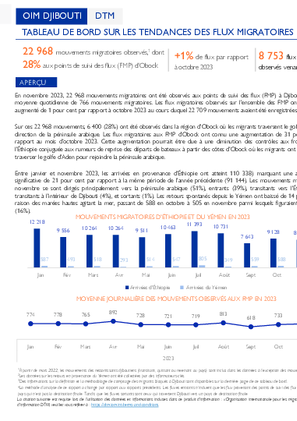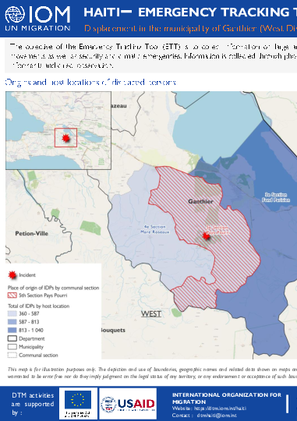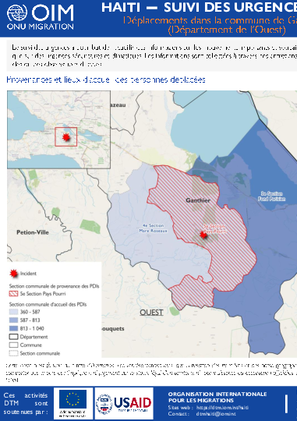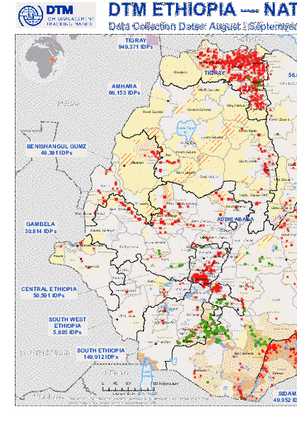-
Countries
-
Data and Analysis
-
Special Focus
-
Crisis Responses

Contact
DTM Chad, dtmtchad@iom.int
Language
English
Location
Chad
Snapshot Date
Dec 15 2023
Activity
- Survey
- Flow Monitoring Survey
• Over 550,000 people have crossed into Chad since the onset of the crisis in Sudan. IOM estimates that more than 109,000 among them are Chadian returnees and expects this number to rise to 150,000 by the end of March 2024, due to renewed conflict in Darfur.
• In coordination with CNARR and humanitarian organizations, IOM has counted 86,604 returnees and counted 346 third-country nationals (from South Sudan, Niger, Ethiopia, the Central African Republic, Burkina Faso, Nigeria and Uganda) in 41 localities in three provinces.
• Most of the returnees currently live in spontaneous locations near the border and are in urgent need of food, water, sanitation and hygiene, shelter, household items, health, and protection.
• IOM is relocating returnees from Adre to a site in Tongori in coordination with authorities. In total, 7,567 individuals have so far been relocated. Separate designated ambulatory vehicles were used to transport the most vulnerable, including people with disabilities. Furthermore, IOM has supported the establishment of a site governance structure with representatives elected by the site residents and is supporting the establishment of community groups (women, youth, community watch, etc.).
• IOM is coordinating with local authorities, embassies and diplomatic representations for the safe transfer and voluntary return of third-country nationals (TCNs) from Ethiopia, South Sudan, Sierra Leone, and Cameroon to N’Djamena.
• IOM works with a range of operational partners in the returnee response including the Government of Chad, UNHCR, OCHA, LWF, PUI, UNICEF, MSF, UNFPA, LMI, ICRC, IRC, ACTED, the Chadian Red Cross, HELP-Tchad, ATURAD, Concern Worldwide, COOPI, INTERSOS, and WFP

Contact
DTM Somalia, IOMSomaliaDTM@iom.int
Language
English
Location
Somalia
Period Covered
Nov 26 2023
Dec 09 2023
Activity
- Mobility Tracking
- Event Tracking
In response to the Somalia’s severe drought beginning in November 2021, DTM Somalia launched an Emergency Trends Tracking (ETT) tool first in Gedo and Bay regions in 2022, and subsequently in Hiraan, Banadir and Middle Shabelle regions in 2023 to monitor drought related displacement trends and hotspots in support of operational planning. However, during the first half of 2023, conflict and flooding displacements have been significant. Therefore, DTM restructured its ETT tool to capture multi-shock displacements (drought, flood, conflict and other) from October 2023. In December 2023, ETT coverage has been expanded to Afgoyee district in Lower Shabelle region to cover the migration corridor between Afgoyee and Mogadishu towns.
ETT is a crisis-based tool that tracks sudden displacement triggered by specific events or emerging crises. The objective of ETT is to help prioritize humanitarian response and to enable partners to deliver rapid assistance.
Between August and September 2023, IOM’s DTM deployed Site Assessment (SA) Round 34 and Village Assessment Survey (VAS) Round 17, carrying out a multisectoral location assessment. It is to be noted that Amhara region was largely uncovered this round due to increased insecurity, and both the IDP and returning IDP caseloads should likely be higher. The National Displacement Map visualizes locations of displacement, density of displacement caseload, primary reasons for displacement, estimated displacement figures, and access constraints.
Contact
DTM Haiti, DTMHaiti@iom.int
Location
Haiti
Activity
- Mobility Tracking
- Baseline Assessment
Period Covered
Jun 12 2023 -Nov 10 2023
From June 12th to November 10th 2023, the DTM team identified 197,999 internal displaced persons and 36,785 internal returnees across three departments West (146,584 IDPs and 26,301 returnees), Center (28,975 IDPs and 1,298 returnees from round 1) and Artibonite (22,440 IDPs and 9,186 returnees from round 2) . During this round, 83 sites were assessed and hosting in total 82,649 IDPs.
Due to security issues, the locations/sites in Center and Artibonite departments have not been assessed and respectively the rounds 1 and 2 figures were reported.
A more detailed version of this dataset is available, to get access kindly click on the 'Request Access' button
Population Groups
IDPs
Returnee (Previously Internally Displaced)
Survey Methodology
Unit of Analysis Or Observation
Admin Area 4
Site or Location
Type of Survey or Assessment
Key Informant
Keywords
Geographical Scope Partial Coverage
Administrative boundaries with available data
The current dataset covers the following administrative boundaries

Contact
DTM Djibouti, DTMDjibouti@iom.int
Language
English
Location
Djibouti
Period Covered
Nov 01 2023
Nov 30 2023
Activity
- Flow Monitoring
En novembre 2023, 22 968 mouvements migratoires ont été observés aux points de suivi des flux (FMP) à Djibouti, avec une moyenne quotidienne de 766 mouvements migratoires. Les flux migratoires observés sur l'ensemble des FMP ont légèrement augmenté de 1 pour cent par rapport à octobre 2023 au cours duquel 22 709 mouvements avaient été enregistrées. Sur ces 22 968 mouvements, 6 400 (28%) ont été observés dans la région d'Obock où les migrants traversent le golfe d'Aden en direction de la péninsule arabique. Les flux migratoires aux FMP d'Obock ont connu une augmentation de 31 pour cent par rapport au mois d’octobre 2023. Cette augmentation pourrait être due à une diminution des contrôles aux frontières avec l'Éthiopie conjuguée aux rumeurs de reprise des départs de bateaux à partir des côtes d’Obock où les migrants ont l’habitude de traverser le golfe d'Aden pour rejoindre la péninsule arabique. Entre janvier et novembre 2023, les arrivées en provenance d’Éthiopie ont atteint 110 338) marquant une augmentation significative de 21 pour cent par rapport à la même période de l'année précédente (91 144). Les mouvements migratoires en novembre se sont dirigés principalement: vers la péninsule arabique (51%), entrants (39%), transitants vers l'Éthiopie (5%), transitants à l'intérieur de Djibouti (4%), et sortants (1%). Les retours spontanés depuis le Yémen ont baissé de 14 pour cent en raison des marées hautes agitant la mer, passant de 588 en octobre à 505 en novembre parmi lesquels figuraient 79 femmes (16%).

Contact
DTM Djibouti, DTMDjibouti@iom.int
Language
English
Location
Djibouti
Period Covered
Nov 01 2023
Nov 30 2023
Activity
- Flow Monitoring
In November 2023, 22,968 migratory movements were observed at flow monitoring points (FMPs) in Djibouti, with a daily average of 766 migratory movements. Migration flows observed across all FMPs increased slightly by (1%) compared to October 2023 during which 22,709 movements were recorded. Of these 22,968 movements, 6,400 (28%) were observed in the Obock region where migrants cross the Gulf of Aden towards the Arabian Peninsula. Migration flows at the Obock FMP increased by (31%) compared to October 2023. This increase could be due to a reduction in border controls with Ethiopia combined with rumors of resumption of boat departures from the coasts of Obock where migrants are used to crossing the Gulf of Aden to reach the Arabian Peninsula. Between January and November 2023, arrivals from Ethiopia (110,338) saw a significant increase of 21% compared to the same period of the previous year (91,144). Migration movements in November were mainly: towards the Arabian Peninsula (51%), inbound (39%), transiting towards Ethiopia (5%), transiting within Djibouti (4%), and outgoing (1%). Spontaneous returns from Yemen fell by (14%) due to high tides agitating the sea, going from 588 in October to 505 in November, including 79 women (16%).
Between August and September 2023, IOM’s DTM deployed Site Assessment (SA) Round 34 and Village Assessment Survey (VAS) Round 17, carrying out a multisectoral location assessment. It is to be noted that Amhara region was largely uncovered this round due to increased insecurity, and both the IDP and returning IDP caseloads should likely be higher. The National Displacement Map visualizes locations of displacement, density of displacement caseload, primary reasons for displacement, estimated displacement figures, and access constraints.

Contact
dtmhaiti@iom.int
Language
English
Location
Haiti
Period Covered
Dec 18 2023
Dec 19 2023
Activity
- Mobility Tracking
- Event Tracking
On December 18th, an armed attack occurred in downtown Ganthier, specifically in the 5th communal section of Pays Pourri, which is situated within the municipality of Ganthier. As a consequence of this incident, approximately 388 households, totaling 1,940 individuals, have been displaced within the same municipality. Currently, these displaced individuals have sought refuge with host families, with the majority finding shelter in the communal section of Fond Parisien.

Contact
dtmhaiti@iom.int
Language
French
Location
Haiti
Period Covered
Dec 18 2023
Dec 19 2023
Activity
- Mobility Tracking
- Event Tracking
Le 18 décembre, une attaque armée a eu lieu au centre-ville de Ganthier, dans la 5ème section communale de Pays Pouri, située dans la commune de Ganthier. Ces événements ont entraîné le déplacement d'environ 388 ménages, comprenant 1 940 individus, au sein de la même commune. Toutes ces personnes déplacées ont trouvé refuge auprès de familles d'accueil. La section communale de Fond Parisien accueille plus de la moitié des personnes déplacées.

Contact
DTM Sudan; dtmsudan@iom.int
Language
English
Location
Sudan
Period Covered
Dec 07 2023
Dec 13 2023
Activity
- Mobility Tracking
- Baseline Assessment
Overview
From 15 April 2023, armed clashes erupted between the Sudanese Armed Forces (SAF) and the Rapid Support Forces (RSF) in multiple cities across Sudan. Clashes initially took place in cities across Northern and Khartoum states, later spreading across the Darfur and Kordofan regions.


